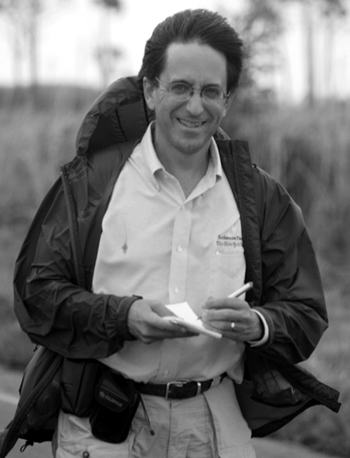Lecture: Andrew Revkin
Andrew Revkin. Photo: Courtesy of Andrew Revkin. Peter West/National Science Foundation. © Peter West.
RELATED:
Andrew Revkin knows how to wait for a story. For three years, he waited for climate researchers to invite him on a trip to the North Pole. The trip only lasted three days, but the images he captured with his video camera eventually made their way into Arctic Rush (2005), Revkin's documentary for the Discovery-Times channel, which won the National Association of Science Writers' Science in Society award later that year.
Revkin, an environmental reporter for The New York Times, spoke to about 30 students and faculty members at New York University’s journalism department on March 27, 2007. Addressing the uses of multimedia techniques, like those he employed to report on climate change in Arctic Rush, Revkin admitted that he’s always had a passion for photography and that he appreciates the power conveyed by images—especially for environmental stories.
Robert Lee Hotz, an NYU writer in residence who worked with Revkin when he was starting out as a reporter at The Los Angeles Times, moderated the lecture. Hotz told students how journalists often have to be entrepreneurial to find success on the Web. “Andy is an excellent example of this,” he said, referring to Revkin’s determination to take news coverage beyond the print medium.
For Revkin, who described the Web as an “infinite realm,” multimedia reporting has proven more effective than prose alone for reporting about climate change.
For Revkin, who described the Web as an “infinite realm,” multimedia reporting has proven more effective than prose alone for reporting about climate change. He said that he and other journalists covering climate change frequently use evocative images, such as glaciers crashing into the sea, to get their point across. However, Revkin said, when using this kind of powerful image, reporters have an even greater responsibility to get their facts right. Without the proper context, visuals—especially those from video—can come across as sensationalistic.
Revkin pointed out that the science involved with figuring out how global warming affects the planet can be complicated and confusing. “The weird thing about climate change,” he explained, “is that there is no smoking gun.” Consequently, environmental reporters often struggle to present the perils of climate change because the effects of global warming are not always immediately apparent. “We’re not shaping our climate in a meaningful way," he said. "We’re shaping our grandchildren’s climate in a meaningful way."

Andrew Revkin. Photo: Courtesy of Andrew Revkin. Photo: Yoni Brook/The New York Times. © 2004 Yoni Brook.
At one point, Dan Fagin, associate director of NYU’s science, health and environmental reporting program, asked Revkin if he felt the spirit of empiricism gets lost when journalists report via multimedia.
Revkin shrugged. "It's a fine line," he answered. "It all comes back to the question: Can you do Times quality journalism with video?" He added that he is confident that it is possible to produce multimedia stories about climate change and other scientific topics that are both accurate and entertaining.
At the close of the lecture, Revkin noticed a digital recorder sitting on the table in front of him. He told the students that the technology available today makes it possible for any of them to add multimedia elements to their stories. “That little recorder there,” he said, smiling, “I just took the exact same thing to the Everglades.”

